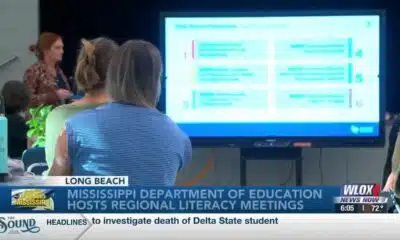News from the South - Texas News Feed
Glen Powell look-alike contest draws crowds in Austin | FOX 7 Austin
SUMMARY: A Glenn Powell lookalike contest in Austin, Texas, celebrated the actor’s growing local popularity, dethroning Matthew McConaughey as UT Austin’s cultural icon. Over a dozen contestants vied for the title at Auditorium Shores, with Maxwell Bronstein crowned the winner. His resemblance to Powell earned him $5, a cowboy hat, free queso for a year, and praise from Powell’s mom, who FaceTimed during the event. Powell, appearing via video, expressed his love for Austin and offered the winner’s family a cameo in his next movie. The event highlighted Powell’s charm and connection to his hometown.
Hundreds gathered in Auditorium Shores in hopes of picking out Glen Powell 2.0. and even the actor and his mom were involved.
#FOX7Austin brings you the important stuff like breaking news, weather, and local stories out of Central #Texas. But also plenty of fun stuff, like Pet of the Weekend, the best of our archives, and all those ‘only-in-#Austin’ stories.
News from the South - Texas News Feed
Frustrated with poor play against UTEP, Arch Manning will 'get back to basics'
SUMMARY: Texas quarterback Arch Manning and coach Steve Sarkisian acknowledge the team’s underwhelming offensive performance in a 27-10 win over UTEP. Manning completed 11 of 25 passes for 114 yards with a touchdown and an interception, frustrating fans expecting a stronger showing at home. Despite a rough first half with 10 consecutive incompletions, Manning showed flashes of promise and scored twice on the ground. Sarkisian emphasized Manning’s mental struggle rather than physical injury and expressed confidence in his growth and consistency. Manning committed to improving fundamentals and handling in-game pressure ahead of tougher matchups, including their SEC opener against Florida on Oct. 4.
The post Frustrated with poor play against UTEP, Arch Manning will 'get back to basics' appeared first on www.kxan.com
News from the South - Texas News Feed
Texas nursing students return from life-changing internship in Africa
SUMMARY: Two Texas nursing students, Tom Strandwitz and Valerie Moon, participated in Mercy Ships’ inaugural nursing internship aboard the Africa Mercy hospital ship in Madagascar. Selected from nationwide applicants, they gained hands-on experience in various departments, providing free surgeries and care in underserved regions. Their travel expenses were covered by over $11,000 raised through community GoFundMe campaigns. Both students were deeply impacted by patient interactions, such as cataract surgeries restoring sight and building trust with families. The internship broadened their perspectives on global health care. They plan to continue careers in intensive care and public health, with hopes to return to international nursing missions.
Read the full article
The post Texas nursing students return from life-changing internship in Africa appeared first on www.kxan.com
News from the South - Texas News Feed
Austin becoming FEMA-approved emergency alert authority, planning 1st test alert
SUMMARY: On Monday, Sept. 29, Austin will conduct a test of the Integrated Public Alert and Warning System (IPAWS), becoming a FEMA-approved alerting authority able to send emergency alerts via Wireless Emergency Alerts (WEA) to cell phones and Emergency Alert System (EAS) messages to TV and radio. This coordinated test at 3 p.m. will cover the city across its three counties—Travis, Hays, and Williamson. The alerts will clearly indicate a test and require no action. IPAWS allows authenticated, geotargeted emergency notifications without subscription, enhancing public safety communication. More details are available at ReadyCentralTexas.org and Ready.gov/alerts.
The post Austin becoming FEMA-approved emergency alert authority, planning 1st test alert appeared first on www.kxan.com
-
News from the South - Florida News Feed6 days ago
Orlando restaurant owner invites artists to parking lot amid federal fight against street art
-
Local News6 days ago
DNA evidence found near scene of Charlie Kirk’s shooting matches suspect, FBI director says
-
Our Mississippi Home6 days ago
Family of Curious George Creators to Visit de Grummond in Hattiesburg
-
SuperTalk FM5 days ago
Hyde-Smith, Warnock team up to recognize Gold Star Families Remembrance Week
-
Mississippi News Video6 days ago
The Mustard Seed
-
News from the South - North Carolina News Feed7 days ago
White House officials hold prayer vigil for Charlie Kirk
-
News from the South - Georgia News Feed7 days ago
Jonesboro band culture responsible for global legacy | FOX 5
-
Mississippi News Video5 days ago
‘Little quiet light’: Family remembers Delta State University student found dead on campus









































